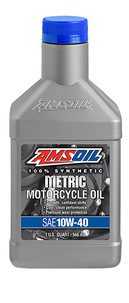INDEPENDENT DEALER
Fort Worth, TX & Southlake | (888) 459-9958 / (817) 431-6664
Why Using Motorcycle Oil in Your Bike is Better?
According to an industry survey, U.S. bikers value engine protection and quality above all else.
Over 80 percent of survey respondents rate engine protection and quality as important or very important when selecting motorcycle oil. Viscosity grade and motorcycle-specific formulations are also important or very important to a majority of respondents. Interestingly, price was the sixth most important factor, indicating most bikers are willing to pay a premium for motorcycle oils that help them get the best performance and most years from their engines. Results indicate what motorcyclists want in a motor oil is exactly what AMSOIL Synthetic Motorcycle Oil delivers.
Keeping Bikes Longer
Keeping Bikes Longer
The demographics of the U.S. motorcycle fleet may have played a large role in how bikers responded to the survey. Sales of new bikes, as reported by the Motorcycle Industry Council, reached 452,400 in 2012. However, over half of the 10 million bikes in the U.S. fleet are more than seven years old while almost 25 percent predate 1995. Bikers are keeping their motorcycles longer and selecting lubricants that help them do so by maximizing engine protection and longevity.
Motorcycle-Specific Formulations
Bikers also value motor oils formulated specifically for motorcycles, demonstrating that many understand the unique challenges motorcycles present to lubricants and the need to use lubricants formulated to meet those challenges. Motorcycles run hotter and at higher rpm than passenger cars/light trucks – conditions that require robust oils formulated to resist viscosity loss due to extreme heat and mechanical shear. In many bikes, the oil must lubricate the engine, transmission and primary chaincase simultaneously. Effectively protecting against engine and gear wear while delivering superior clutch performance requires a balanced oil tailored to protect all critical areas. Passenger-car/light-truck motor oils simply aren’t designed to meet the needs of motorcycles. However, 59 percent of respondents indicated an API-certified oil was very important, indicating there is still limited knowledge of lubricant specifications and their applicability.
Synthetics on the Rise
Full-synthetic oils rate as important or very important to 42 percent of respondents. Where bikers once had to be convinced of synthetics’ superiority, many now understand synthetics are better-suited to protect their engines in the toughest riding conditions. The survey also found that the strength of brand reputation and explicit product quality claims are two key differentiators in the market. The AMSOIL brand signifies industry-leading quality due to the company’s presence at the largest and most influential motorcycle rallies in North America – including Sturgis, Daytona Bike Week and Laconia Motorcycle Week – and its sponsorships in the motorcycle racing markets – including AMSOIL Arenacross, Erik Buell Racing, Monster Energy Supercross and Loretta Lynn’s AMA Amateur National Motocross Championships.
Six Differences
- Operational Speed: Motorcycles tend to operate at engine speeds significantly higher than automobiles. This places additional stress on engine components, increasing the need for wear protection, and subjects lubricating oils to higher loading and shear forces. Elevated operating rpm also promote foaming, which can reduce an oil’s load-carrying ability.
- Compression Ratios: Motorcycles tend to operate with higher engine compression ratios than automobiles, which places additional stress on engine components and increases engine operating temperatures, placing greater demands on motorcycle oil to reduce wear. Higher operating temperatures also promote thermal degradation of the oil, reducing its life expectancy and accelerating the formation of engine deposits.
- Horsepower/Displacement Density: Motorcycle engines typically produce more horsepower per cubic inch than automobile engines, which exposes the oil to higher temperatures and stress.
- Variable Engine Cooling: In general, automotive applications use a sophisticated water-cooling system to control engine operating temperature. Similar systems can be found in motorcycle applications, but most are air-cooled or use a combination air/oil design. Operating temperatures in air-cooled bikes can skyrocket in stop-and-go traffic, promoting oxidation and causing oil to thin, reducing their load-carrying ability.
- Multiple Lubrication Functionality: Many motorcycles have a common sump supplying oil to both the engine and transmission. In such cases, the oil is required to meet the needs of both the engine and the transmission gears. Many motorcycles also incorporate a wet clutch within the transmission that uses the same oil.
- Inactivity: Whereas automobiles are used on a daily basis, motorcycle use is usually periodic and, in many cases, seasonal. These extended periods of inactivity place additional stress on motorcycle oils. In these circumstances, rust and acid corrosion protection are of critical concern.
No matter the conditions or the bike, AMSOIL synthetic motorcycle oils deliver the premium protection and performance your bike deserves. They are designed to control oxidation and maintain viscosity at higher temperatures, promote consistent clutch feel and lengthen clutch life, reduce engine stress and control wear and deposits in high-compression, high-temperatures motorcycle applications. V-twin or metric, AMSOIL has you covered.
AMSOIL Motorcycle Products: Something for Everyone
Dirt Bike, V-Twin and Metric Oils fill out the AMSOIL Synthetic Motorcycle Oil line.
Dirt Bike

To satisfy the demand for dirt-bike-specific oil, AMSOIL developed Synthetic Dirt Bike Oil in three viscosities, including 10W-40 (DB40), 10W-50 (DB50) and 10W-60 (DB60).
AMSOIL Synthetic Dirt Bike Oil is designed to deliver consistent clutch feel and improve the performance of both bike and rider. Superior clutch consistency lets off-road (trail) riders expertly navigate trail obstacles without sacrificing momentum, helping them stay at the front of the pack. It also allows motocross racers the control needed to accurately time the gate drop to grab the holeshot.
V-Twin

AMSOIL expanded its line of V-Twin lubricants in March to include new AMSOIL 20W-40 Synthetic V-Twin Motorcycle Oil (MVI), AMSOIL Synthetic V-Twin Transmission Fluid (MVT) and AMSOIL Synthetic V-Twin Primary Fluid (MVP). AMSOIL 20W-50 Synthetic Motorcycle Oil (MCV) and AMSOIL SAE 60 Synthetic Motorcycle Oil (MCS) also fall into the V-Twin Family.
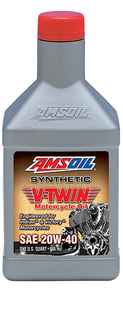 20W-40 Synthetic V-Twin Motorcycle Oil
20W-40 Synthetic V-Twin Motorcycle OilAMSOIL 20W-40 Synthetic V-Twin Motorcycle Oil was developed to cater to the increasing popularity of Victory and model-year 2013 and newer Indian motorcycles*, providing riders with the security of knowing their bike engines are protected against extreme heat, internal wear and damaging sludge and deposits.
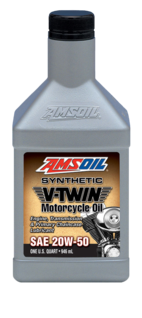 20W-50 Synthetic Motorcycle Oil
20W-50 Synthetic Motorcycle OilAMSOIL 20W-50 Synthetic Motorcycle Oil provides superior protection for newer V-Twins, including the ever-popular Harley-Davidson*. In addition to being a cost-effective, high-performance alternative for original equipment manufacturer (OEM)-branded lubricants, AMSOIL Synthetic Motorcycle Oil provides superior primary chaincase, transmission and engine protection in one convenient package.
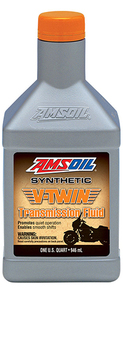 Synthetic V-Twin Transmission Fluid
Synthetic V-Twin Transmission FluidAMSOIL V-Twin Synthetic Transmission Fluid is specifically designed for bikers who prefer a dedicated transmission fluid over a multi-use lubricant. Its frictional properties deliver smooth shifts and it helps quiet transmission noise, letting riders focus on enjoying the ride. V-Twin Synthetic Transmission Fluid is Warranty Secure™ and will not void your motorcycle’s warranty. It is a cost-effective, high-performance alternative to original equipment manufacturer (OEM) fluids.
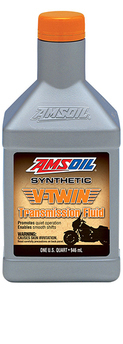 Synthetic V-Twin Transmission Fluid
Synthetic V-Twin Transmission FluidAMSOIL V-Twin Synthetic Transmission Fluid is specifically designed for bikers who prefer a dedicated transmission fluid over a multi-use lubricant. Its frictional properties deliver smooth shifts and it helps quiet transmission noise, letting riders focus on enjoying the ride. V-Twin Synthetic Transmission Fluid is Warranty Secure™ and will not void your motorcycle’s warranty. It is a cost-effective, high-performance alternative to original equipment manufacturer (OEM) fluids.
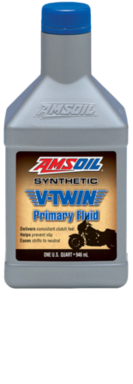 Synthetic V-Twin Primary Fluid
Synthetic V-Twin Primary FluidV-Twin Synthetic Primary Fluid is formulated with a balanced additive system that provides consistent clutch performance and feel. It helps riders easily find neutral and promotes smooth acceleration, whether in stop-and-go city conditions or when on the highway. Its superior load-holding capacity helps prevent clutch slip for confident takeoffs.
Metric
To round out the entire motorcycle oil line, AMSOIL 10W-30 (MCT) and 10W-40 Synthetic Metric Motorcycle Oil (MCF) were repackaged and reintroduced with a more specific focus on metric motorcycle applications. AMSOIL Synthetic Metric Motorcycle Oil is formulated to provide smooth shifts, excellent wear protection, extreme heat resistance and trouble-free operation in metric cruisers, sport bikes and touring bikes, including Kawasaki, Yamaha, Suzuki and Honda.*
 10W-30 Synthetic Motorcycle Oil
10W-30 Synthetic Motorcycle OilAMSOIL Synthetic Metric Motorcycle Oil delivers the benefits most important to riders, including premium wear protection; smooth, confident shifts and cool, clean performance. With AMSOIL Synthetic Metric Motorcycle Oil, riders enjoy the confidence and security that comes with providing their bikes maximum protection and performance.



